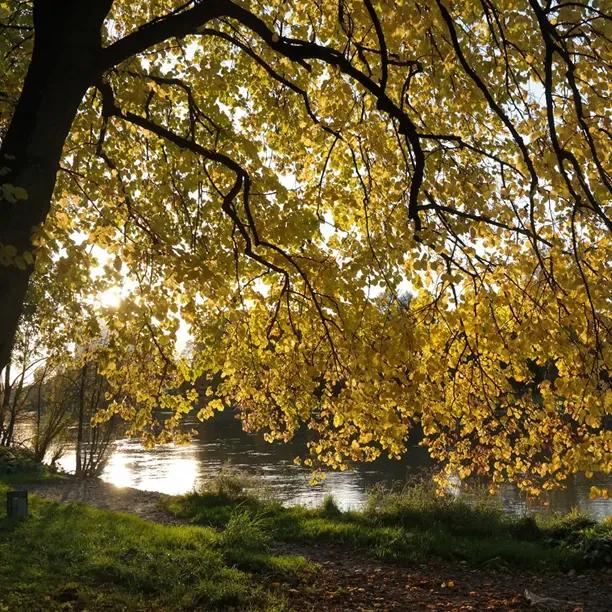Red-Twigged Lime Trees
Honest Delivery Prices- Native. Red young stems.
- Sizes: Standards only.
- RHS Award of Garden Merit
- Max. Height: 25m
- Bareroot Delivery: Nov-Mar.
Recommended extras
Description
Tilia platyphyllos Rubra
Tilia platyphyllos Rubra, is a variety of the native Broad Leaved Lime with lustrous, ruddy red young stems and buds. It is a smaller, less vigorous tree than its parent, which makes it easier to maintain as a roadside tree where space it limited. In early summer, it produces lots of simple, sweetly scented white flowers that aren't very showy but which provide bountiful nectar for bees. The seeds are attached by a stalk to a modified leaf which spins around enough to carry them away from the parent tree when they fall; if seedlings appear on your lawn, just run over them with the lawn mower. Red-twigged lime doesn't have such a powerful suckering habit as other limes making it a better choice as a specimen tree. Like all lime trees it is very pollution resistant. Left to grow freely, this tree will spread out into a wide, pyramidal shape but it is very happy to be pollarded to restrict its size. Tilia platyphyllos rubra can reach a height of about 12+ metres.
Browse our variety of lime trees or our full range of trees.
Did You Know?
Older books may list this tree as 'Corallina'. It is a naturally occurring variety, sometimes found in old woodland, and the trees that we grow are cloned vegetatively to ensure that they have a consistent colour and shape. You can make a tea from the first new flowers of the year, but do not use older flowers as they may make you feel sick. (Always this sort of thing carefully before actually doing it...)
How Standard Trees are Measured:
All the plants in the ornamental trees section are graded as standardss, which means that they are measured by their girth in centimetres 1 metre above ground level (basically, their trunk's waist measurement). They aren't measured by their height, which will vary. So, a 6/8 standard has a trunk with a circumference of 6-8 centimetres and an 8/10 standard has a trunk 8-10 centimetres around. This measurement makes no difference to the tree's final height.
Standard trees are 2 - 3.5 metres tall (on average) when they arrive; they are the most mature trees that you can buy from us. We cannot tell you precisely how tall your trees will be before we deliver them.
Planting Instructions
Notes on planting Red Twig Lime trees:
Tilia platyphyllos Rubra is a hardy tree that will grow on any fertile soil and it does well in partial shade. It likes heavy clay and it is suitable for inner city planting.
Lime trees don't like boggy, wet ground or poor, dry soils.
Prepare your site before planting:
It is good to dig over the site where you plant a tree several months in advance. Kill the weeds first: for tough weeds like nettles, brambles and ground elder, you will usually need a weed-killer to get rid of them. When you dig the soil over, remove stones and other rubbish and mix in well rotted compost or manure down to the depth of about 2 spades.
Watch our video on how to plant a tree for full instructions.
Remember to water establishing trees during dry weather for at least a year after planting.
Tree Planting accessories:
Prepare your site for planting by killing the weeds and grass.
You can buy a tree planting pack with a wooden stake & rubber tie to support the tree and a mulch mat with pegs to protect the soil around the base of your tree from weeds and drying out.
We suggest that you use mycorrhizal "friendly fungi" on the roots of all newly planted large trees: if your soil quality is poor, we strongly recommend it.
You can also improve your soil with bonemeal organic fertiliser.
After you plant a tree, the most important thing to do is water it in dry weather. You will also need to weed around the plants. Watering should be thorough, so the ground is soaked. Let the soil almost dry out before watering again. Watering & weeding will be necessary for at least a year after planting.
If your trees do need pruning, it is ideal to do this in winter. Always hire a tree surgeon to remove large branches. Lime trees are vigorous and quickly recover from a severe pruning.
Special notes on caring for Red Twig Lime trees:
Red Twig Lime is a very tough tree that shouldn't need special attention once it has established.
Remember to check the stake and tie supporting your trees a few times a year. Tighten the tie if it becomes loose and loosen it as the tree grows. Make sure that the tree's trunk isn't rubbing against the stake.
Hygiene & Diseases:
Dead, damaged or diseased wood can be pruned off as soon as it appears.
Disinfect your pruning tools between every cut if there is any sign of disease.
Burn or dispose of any diseased material, do not compost it.



